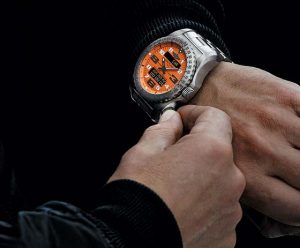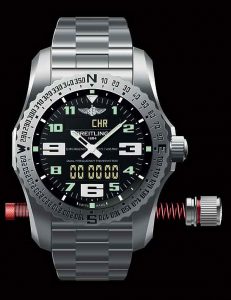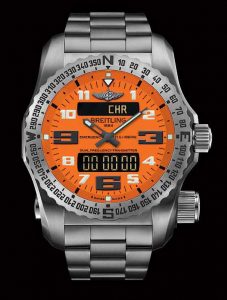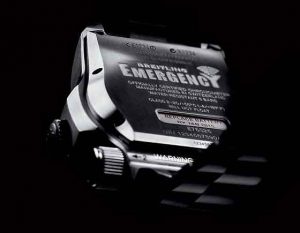Breitling introduced the Emergency II — successor to the wildly popular Breitling Emergency, and the first-ever watch with a dual-frequency locator beacon — at Baselworld 2013. However, the Cheap Breitling Replica planned U.S. retail release has been stalled for nearly two years awaiting approval from the FCC, which regulates the airwaves over which its built-in rescue signal operates. On June 23, pilots, sailors, and other adventurers who have patiently waited for the chance to purchase the Emergency II received good news. At a press conference aboard the U.S.S. Intrepid Air and Space Museum in New York, co-hosted by pilot, astronaut and Breitling brand ambassador Mark Kelly, Cheap Breitling announced that the government red tape had finally been cut: the company received its necessary FCC waiver, and the Breitling Emergency II would finally be available at retail on July 1. Here’s what you need to know about this world’s-first timepiece.
The original Breitling Emergency, introduced in 1995, was the first wristwatch with a built-in emergency microtransmitter. Designed to enable accurate homing in on pilots or passengers following a plane crash, it operated on the 121.5 MHz international air distress frequency. Pilots prized it for its utility: it could be worn constantly on the wrist and serve as a supplement to standard onboard aircraft equipment. Around 40,000 Breitling Emergency watches have been sold since their launch. The Breitling Emergency II represents the next generation of its predecessor’s life-saving microtechnology. Breitling Replica Watches developed the Emergency II in conjunction with major scientific institutes, and the watch includes three innovative new features developed specifically for it, including a new rechargeable battery, a miniaturized dual frequency transmitter and an unprecedented integrated antenna system. With the integration of these microelectronic and microtechnical inventions, Breitling set out to create “a safety and survival instrument in all distress situations on land, at sea and in the air.”
The international Cospas-Sarsat system, whose mission is to provide accurate and reliable distress alert and homing data, uses a network of satellites in low-altitude earth orbit and in geostationary orbit as well as ground receiving stations and control and coordination centers. Search-and-rescue teams use this information to assist persons in distress; since its launch in 1985, the system has helped save more than 26,000 lives. Up until 2009, Cospas-Sarsat used the 121.5 MHz analog frequency for the alert and homing phases of the Cheap Breitling Replica rescue process. That year, it decided to phase out the 121.5 MHz frequency and began receiving alert signals on the new, digital 406 MHz frequency instead, to provide better security and to reduce the number of false alarms. Hence the need for a new Emergency watch that complied with the new satellite frequency. Making matters a bit more complicated, the 121.5 MHz frequency is still used on land, by ships at sea and by airborne aircraft, so modern distress beacons must offer dual frequencies for the most accurate homing.
Cheap Breitling accepted the challenge with the invention of its microtransmitter PLB, which alternately operates on two separate frequencies over a 24-hour period. The watch first transmits a digital signal on the 406 MHz frequency, intended for satellites and lasting 0.44 seconds every 50 seconds, then an analog signal on the 121.5 MHz homing and rescue frequency, lasting 0.75 seconds every 2.25 seconds. To accomplish this task, Breitling Replica Watches worked with an institute that developed technology for the aerospace and defense industries to create the watch’s ingenious antenna system, with two miniature antenna sections housed in the lower part of the watch and activated by a knob in the lower right side of the case. To deploy the antenna, which automatically activates the transmitter, you unscrew and pull out the knob’s cap. The cap automatically comes free of the antenna when it is deployed to the right length, at which point the cap of the second section of the antenna is automatically released. The antenna length varies according to the wavelength; depending on the circumstances, the transmitter uses either one antenna section or both; this is a first for a locator beacon.






